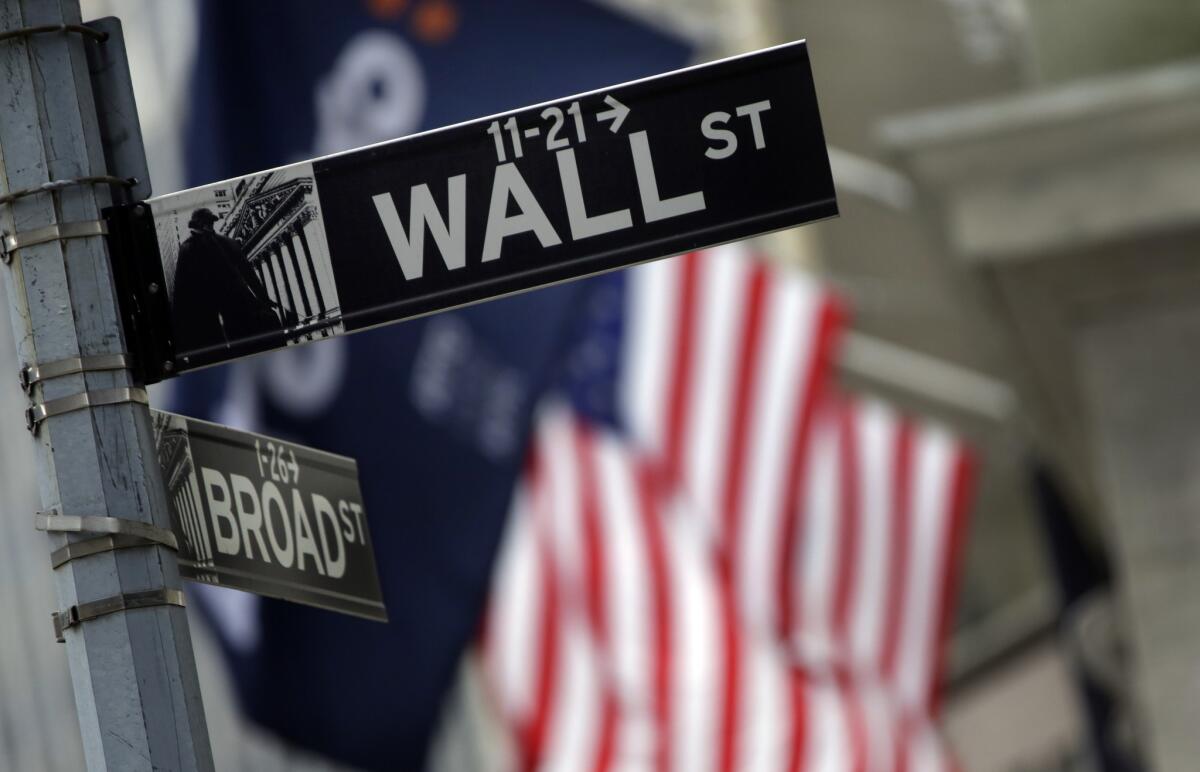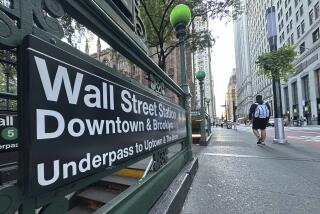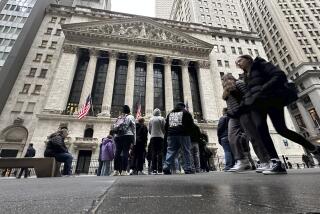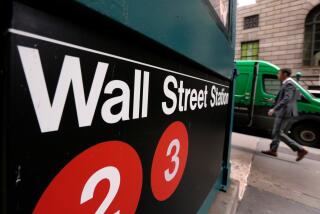Dow’s best day since 1933: Stocks surge on hopes of coronavirus stimulus

- Share via
The Dow Jones industrial average surged Tuesday, posting its best day since 1933, as Congress and the White House neared a deal to inject nearly $2 trillion of aid into the coronavirus-ravaged economy.
The Dow leaped 11.4%, while the more closely followed Standard & Poor’s 500 index jumped 9.4%, as a wave of buying around the world interrupted what has been a brutal month of nearly nonstop selling. Investors released some frustration that had pent up over days of watching the Senate stalemate over the crucial rescue package.
Despite the gains, investors were far from saying markets have hit bottom. Rallies nearly as big as this have punctuated the last few weeks, and none lasted more than a day. Economists and investors are still expecting to see some dire economic numbers in the days and weeks ahead.
“Today was a good day, but we would not necessarily see this as turnaround time,” said Adam Taback, chief investment officer at Wells Fargo Private Bank.
Democrats and Republicans said Tuesday that they were close to agreeing on a massive economic rescue package, which will include payments to U.S. households and aid for small businesses and the travel industry, among other things.
Investors were imploring Congress to act, particularly as the Federal Reserve has done nearly all it can to sustain markets, including its latest round of extraordinary aid launched Monday.
“It’s sort of like, keep the patient alive in the emergency room so you can provide some treatment options,” said Katie Nixon, chief investment officer at Northern Trust Wealth Management.
The Dow rose 2,112.98 points to 20,704.91.
The S&P 500, which is much more important to most 401(k) accounts, rose 209.93 points to 2,447.33, its third-biggest gain since World War II. The Nasdaq composite jumped 557.18 points, or 8.1%, to 7,417.86.
The buying circled the world. South Korean stocks surged 8.6%, and Germany’s market jumped 11%. U.S. Treasury yields rose, a sign that investors are feeling less fearful.
The market has seen rebounds like this before, only for them to wash out immediately. Since the stocks sell-off began Feb. 20, the S&P 500 has had six days when it’s risen, and all but one of them were big gains of more than 4%. After them, stocks fell an average of 5% the next day.
“One of the things to be careful about is thinking this will be the panacea or that this fiscal response will be sufficient,” said Eric Freedman, chief investment officer at U.S. Bank Wealth Management.
Ultimately, investors say they need to see the number of new infections peak before markets can find a floor. The increasing spread is forcing companies to park airplanes, shut hotels and close restaurants to dine-in customers. Altogether, estimates suggest at least 10% of the U.S. economy is shutting down, said Rob Sharpe, head of investments and group chief investment officer at T. Rowe Price.
President Trump said Tuesday during a Fox News virtual town hall that he hopes to “open up ” the economy by Easter. Analysts said the pronouncement wasn’t a contributor to the day’s huge rally, attributing the stocks’ gains mostly to the stimulus hopes.
Economists are topping one another’s dire forecasts for how much the economy will shrink this spring because of the closures of businesses, and a growing number say a recession seems inevitable or may already have begun.
Some of the sectors hardest hit by the closures, though, led the way higher Tuesday as expectations rose for incoming aid from the U.S. government.
Norwegian Cruise Line, MGM Resorts and American Airlines Group were all up at least 33%. Energy companies and banks were also strong, though all remain well below where they were a month ago.
Governments and central banks in other countries around the world are unveiling unprecedented levels of support for their economies in an attempt to limit the scale of the upcoming virus-related slump. Germany, a bastion of budgetary discipline, also approved a big fiscal boost.
The gains came even as the first reports arrived showing how badly the outbreak is hitting the global economy. In the United States, a preliminary reading on business activity in March showed the steepest contraction on record, going back to 2009. Reports were also gloomy for Europe.
“Everyone was prepared for a set of shockers, and that is precisely what we got, but they are not a surprise,” said Chris Beauchamp, chief market analyst at IG. “It is at times like this that the market’s propensity to look forward is demonstrated most effectively.”
More gloomy data are nearly assuredly on the way. On Thursday, economists expect a report to show the number of Americans applying for jobless claims easily set a record last week. Some say the number could far exceed 1 million, amid a wave of layoffs, topping the record of 695,000 set in 1982.
Helping to lift sentiment in markets is news that China is preparing to lift the lockdown in Wuhan, the epicenter of the outbreak, and that Italy reported a reduction in the number of new cases and coronavirus-related deaths.
“It’s still early days, of course — perhaps investors can start to envisage life beyond the coronavirus,” said Craig Erlam, senior market analyst at Oanda Europe. “That could make stocks look a little more attractive, although anyone jumping back in now will need to have nerves of steel.”
Despite Tuesday’s big gains, it’s no time to get complacent, Wells Fargo’s Taback said.
“We would caution that the danger is not all behind us at this point,” he said. “We still have not seen numbers that give us an indication of just how bad things are.”
More to Read
Inside the business of entertainment
The Wide Shot brings you news, analysis and insights on everything from streaming wars to production — and what it all means for the future.
You may occasionally receive promotional content from the Los Angeles Times.






